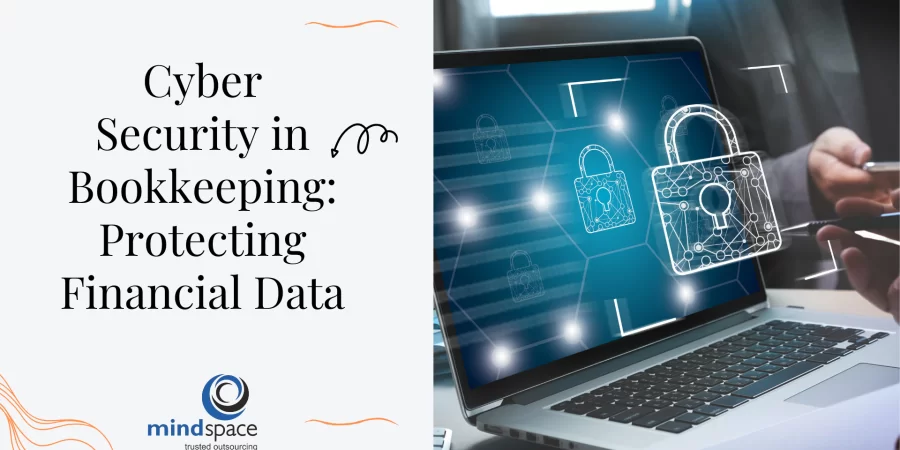Cyber Security in Bookkeeping: Protecting Financial Data
In today’s digital age, businesses rely heavily on technology for various aspects of their operations. One critical area where technology plays a pivotal role is in bookkeeping and financial management. While digital tools and software have undoubtedly made bookkeeping more efficient, they have also introduced new challenges, primarily concerning the security of financial data. Protecting sensitive financial information from cyber threats is paramount, as a breach could lead to significant financial losses and reputational damage. In this blog, we will explore the importance of cybersecurity in bookkeeping and discuss effective strategies to safeguard financial data.
Understanding the Cybersecurity Landscape
Protecting computer systems, networks, and data from theft, damage, or illegal access is the practice of cybersecurity. In the realm of bookkeeping, where vast amounts of financial data are processed and stored digitally, the stakes are high. Cybercriminals are constantly evolving their tactics to exploit vulnerabilities and gain access to sensitive financial information.
The consequences of a cybersecurity breach in bookkeeping can be dire. Financial data breaches can result in financial losses, legal liabilities, regulatory fines, and damage to a company’s reputation. It is essential for businesses of all sizes to adopt a proactive approach to cybersecurity.
Common Cyber Threats in Bookkeeping
Before diving into cybersecurity strategies, it’s essential to understand the common cyber threats that bookkeepers and financial professionals face:
Phishing Attacks: Phishing involves tricking individuals into divulging sensitive information, such as login credentials or financial details, by posing as a trustworthy entity via email or other communication channels.
Ransomware: Ransomware attacks involve encrypting a company’s data and demanding a ransom for its release. If financial data is compromised, it can disrupt operations and result in significant financial losses.
Data Theft: Cybercriminals may infiltrate a system to steal financial data for illicit purposes, such as identity theft or selling the data on the dark web.
Malware: Malicious software can infect a system and disrupt its functionality or steal sensitive financial information.
Effective Strategies for Protecting Financial Data
Employee Training: The first line of defense against cyber threats is a well-trained workforce. Employees should be educated about the risks associated with cyber threats, how to recognize phishing attempts and the importance of maintaining strong passwords.
Secure Access Controls: Implement robust access controls to restrict who can access financial data. Just provide employees access to the data they need to perform their jobs, please. Make sure they follow strict security guidelines.
Data Encryption: Encrypt financial data both in transit and at rest. Encryption converts sensitive information into code to make it unreadable to unauthorized individuals.
Regular Software Updates: Keep all software, including operating systems and security software, up to date. Insecure software is a common target for cybercriminals.
Firewalls and Intrusion Detection Systems: Install firewalls to monitor and control incoming and outgoing network traffic. Additionally, intrusion detection systems can help identify and respond to suspicious activities.
Backup and Disaster Recovery: Regularly back up financial data and develop a disaster recovery plan. This ensures that in the event of a data breach or ransomware attack, data can be restored, minimizing downtime.
Multi-Factor Authentication (MFA): Require MFA for access to financial systems. MFA adds an extra layer of security by verifying the user’s identity through multiple factors, such as a password and a fingerprint or a one-time code.
Vendor Assessment: If your organization relies on third-party vendors for bookkeeping software or services, assess their cybersecurity measures. Ensure they adhere to high-security standards.
Incident Response Plan: Develop a clear and comprehensive incident response plan that outlines steps to take in the event of a cybersecurity breach. Timely and well-coordinated responses can mitigate the damage.
Regular Security Audits: Conduct regular security audits and penetration testing to identify vulnerabilities and weaknesses in your systems. Address any issues promptly.
Compliance with Regulations: Depending on your industry and location, there may be specific regulations governing the security of financial data, such as the General Data Protection Regulation (GDPR) or the Health Insurance Portability and Accountability Act (HIPAA). Ensure compliance with these regulations.
Employee Offboarding Procedures: When an employee leaves the organization, promptly revoke their access to financial systems and data to prevent unauthorized access.
Conclusion
In the digital era, cybersecurity is non-negotiable, especially in bookkeeping and financial management. Protecting financial data from cyber threats is essential to safeguard a company’s financial health, reputation, and legal standing. By implementing robust cybersecurity measures, staying informed about emerging threats, and fostering a culture of security awareness among employees, businesses can minimize the risks associated with cyberattacks and ensure the integrity and confidentiality of their financial data. Remember, in the realm of cybersecurity, prevention is always better than reaction.
Looking for the best security solution to safeguard your financial data? Look no further! Our team specializes in top-notch cybersecurity strategies tailored to the unique needs of bookkeeping and financial management. With our expertise in employee training, secure access controls, data encryption, and proactive threat detection, we provide a comprehensive defense against cyber threats. Don’t wait for a cybersecurity breach to happen – choose us for peace of mind and the utmost protection for your financial data.


